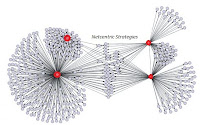I recently wrote an article for The Enterprise Mobility Foundation,
The Next Step in Business Process Optimization: Mobility. In this article I describe the enormous amount of work that has gone into designing and automating business processes and ERPs like SAP. The conclusion of the article is that as sophisticated as ERPs are today, there remains significant feature gaps, especially in extending business processes out to the mobile workforce.
In this article, I want to highlight some areas where there is still much work to be done in field services. In field services, a number of SAP mobility partners like
Clicksoftware and
Syclo have comprehensive field services and enterprise asset management solutions with mobile clients for use on smartphones and ruggedized handhelds. However, there are still feature gaps in the integration of real time data, M2M integration, geotags, business intelligence, augmented reality and multi-media support.
Let me give you a not so futuristic field services scenario to consider. A field services technician arrives at a customer's location. Recognizing the location (based on geospatial data and scheduling data), the service tech's smartphone begins to both display and read, using an audio feed, the customer highlights including recent support issues, account status, warranties, contracts and possible upsell sales opportunities. As the service technician unloads his/her tools and walks toward the worksite, they are getting educated on all the most recent events through their ear piece.
As the service technician passes near various pieces of equipment with a maintenance and repair history the information is both displayed and an audible voice reviews the history. As the service technician enters a building, the blueprint of the building and a map of the location of all equipment under service contracts appears on their screen.
Now let's pretend we are movie directors and insert a flashback - before the service technician was scheduled and dispatched, the field service automation system queried the maintenance and support status of all equipment on the customer's campus. Equipment needing repair or maintenance was identified, parts required were pulled from inventory or ordered for delivery. Required tools and equipment were pre-loaded into the service technician's vehicle and time was allocated to complete all the necessary work on the premises. Consolidating all the work possible during a visit reduces fuel, travel and labor costs.
As the service technician arrives at each piece of equipment, he immediately snaps a digital picture of it. A diagram, with step by step instructions overlays the digital photo and instructs the service technician on how to complete the service most efficiently. The service technician speaks to the mobile application confirming each step until it is completed. This audio file is immediately translated, interpreted and the work order is closed.
If any step in the process takes longer than expected, the mobile application will ask if a digital video file demonstrating the necessary steps would be useful. If the service technician affirms, then the file automatically plays.
If advice from another expert is required, the service technician can request it and the mobile application can initiate a knowledge management process (see solutions from SAP mobility partner's
Leapfactor, Open Text's
Open Text Everywhere, or SAP's Streamworks) that queries experts and connects with them automatically. If a connected expert requests a live video feed of the equipment or the work, the service technician simply aims the smartphone digital video camera at the equipment or activates the hat mounted video camera.
Before each peice of equipment is reached, an automatic M2M (machine-to-machine) communication is sent from the office asking the equipment to perform diagnostics on itself. The diagnostic is completed and wirelessly sent to the service technician's smartphone.
All of the technology in the scenario above exists today. It just has not been integrated all together into specific use cases like the one above. Perhaps SAP partners are waiting for customers to request it or for SAP to document it or for you to suggest it.
*Read the Mobility News Weekly at
http://mobileenterprisestrategies.blogspot.com/p/kevins-mobility-news-weekly.html.
*Read the M2M News Weekly at
http://mobileenterprisestrategies.blogspot.com/p/m2m.html.
***************************************************
Kevin Benedict, SAP Mentor, SAP Top Contributor, Mobile and M2M Industry Analyst
CEO/Principal Consultant, Netcentric Strategies LLC
http://www.netcentric-strategies.com/
www.linkedin.com/in/kevinbenedict
http://twitter.com/krbenedict
***Full Disclosure: I am an independent mobility consultant and Web 2.0 marketing expert. I work with and have worked with many of the companies mentioned in my articles.
***************************************************
http://www.clicksoftware.com/e86e075b-4fca-44c9-bfeb-4efcc978f416/knowledge-center-white-papers-delivery.htm



